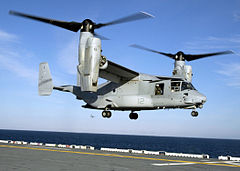
Back Tiltrotor Azerbaijani Aeronau de rotors basculants Catalan Tiltrotor Danish Kipprotor German تیلتروتور Persian Tiltrotor French מטה רוטור HE ティルトローター Japanese 틸트로터 Korean Tiltrotor Dutch

A tiltrotor is an aircraft that generates lift and propulsion by way of one or more powered rotors (sometimes called proprotors) mounted on rotating shafts or nacelles usually at the ends of a fixed wing. Almost all tiltrotors use a transverse rotor design, with a few exceptions that use other multirotor layouts.
Tiltrotor design combines the VTOL capability of a helicopter with the speed and range of a conventional fixed-wing aircraft. For vertical flight, the rotors are angled so the plane of rotation is horizontal, generating lift the way a normal helicopter rotor does. As the aircraft gains speed, the rotors are progressively tilted forward, with the plane of rotation eventually becoming vertical. In this mode the rotors provide thrust as a propeller, and the airfoil of the fixed wings takes over providing the lift via the forward motion of the entire aircraft. Since the rotors can be configured to be more efficient for propulsion (e.g. with root-tip twist) and it avoids a helicopter's issues of retreating blade stall, the tiltrotor can achieve higher cruise speeds and takeoff weights than helicopters.
A tiltrotor aircraft differs from a tiltwing in that only the rotor pivots rather than the entire wing. This method trades off efficiency in vertical flight for efficiency in STOL/STOVL operations.